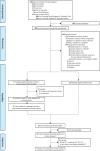Double- versus single-balloon catheters for labour induction and cervical ripening: a meta-analysis
- PMID: 31619189
- PMCID: PMC6796470
- DOI: 10.1186/s12884-019-2491-4
Double- versus single-balloon catheters for labour induction and cervical ripening: a meta-analysis
Abstract
Background: The induction of labour is an increasingly common procedure in the obstetrics field. Various methods have been used to induce labour, among which balloon catheters play an important role. Whether the specifically designed double-balloon catheter is better than the single-balloon device in terms of efficacy, efficiency, safety and patient satisfaction remains controversial. Identifying even small differences between these two devices could be useful to guide clinical practices, to further explore their mechanisms, and to promote a better understanding of the optimal methods for inducing labour.
Methods: Using the population, intervention, comparison, outcomes and study designs (PICOS) principle, we searched the PubMed, EMBASE, OVID, SCI, CENTRAL, ClinicalTrial.gov , and CDSR databases to identify relevant randomised controlled trials (RCTs) from inception through February 14, 2018. The primary outcome was the caesarean delivery rate, and the secondary outcomes focused on efficacy, efficiency, safety, and patient satisfaction. The relative risks or mean differences, including their 95% confidence intervals, were calculated using fixed-effects or random-effects models. All statistical analyses were completed with RevMan version 5.3.
Results: From a total of 1326 articles, 7 RCTs involving 1159 women were included. There were no significant differences in primary outcomes (RR, 0.88 [0.65, 1.2]; p-value, 0.43) or secondary outcomes identified between single- and double-balloon catheters. However, heterogeneity existed for some aspects.
Conclusion: Both kinds of balloon catheter have similar levels of efficacy, efficiency, safety and patient satisfaction; however, the single-balloon method is considered to be more cost-effective.
Keywords: Balloon catheter; Cervical ripening; Labour induction; Meta-analysis.
Conflict of interest statement
We declare that none of the authors have any financial relationships or personal relationships with people, pharmaceutical companies or other commercial entities that have an interest in the subject matter or materials discussed in the article.
Figures
References
-
- Managing complications in pregnancy and childbirth: a guide for midwives and doctors. Second edition. Geneva Switzerland Who 2017. http://reprolineplus.org/system/files/resources/mcpc_guide_eng.pdf. Accessed 02 Jan 2018.
-
- Bishop EH. Pelvic scoring for elective induction. Obstet Gynecol. 1964;24:266–268. - PubMed
-
- DA W: Induction of labour (electronic version). In: Lockwood CJ, editor. UpToDate 2018 [www.uptodate.com] Accessed 02 Jan 2018 .
Publication types
MeSH terms
Grants and funding
LinkOut - more resources
Full Text Sources
Medical




